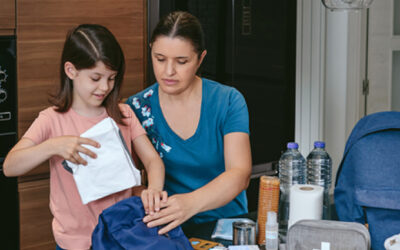With the joy and health benefits of youth sports comes the risk of injury, but there are steps parents can take to enhance their young athlete’s safety.
In this episode of ParentingU, Kyle Pontiff, MD, sports medicine physician with Our Lady of the Lake Children’s Health, shares his expertise when it comes to tween and teen athletes. Topics he covers include the importance of making sports fun for kids, the dangers of overdoing it and the benefits of taking breaks.
Common Youth Sports Injuries
Dr. Pontiff shares that knee and arm injuries are most prevalent among young athletes.
“Some of that comes because they’re not developmentally ready to use that part of their body in that way or not engaging certain other parts of their body,” he says. “We see a lot of injuries related just to overuse.”
Tweens and teens are still growing. Where their tendons attach to the bones are weak points and more susceptible to overuse than in adults. Overusing those muscles can cause irritation.
“That can be in your elbow for a thrower, your knee for a runner or jumper,” Dr. Pontiff says. “You can get those same types of injuries in your feet just from pounding and flexing that foot downward over and over.”
Another common injury is arm fractures, young athletes falling on their wrists with their hands outstretched. Overuse injuries are also common in the upper extremities.
Sports Injury Recovery
Dr. Pontiff’s advice for treatment starts with rest.
“I jokingly tell parents that I went to school for a long time to be able to tell people that if it hurts don’t do it,” he says. “Rest is the biggest therapy and treatment for kids’ injuries, and if it has to be prolonged, it has to be prolonged.”
That may mean a thrower with elbow pain may need to stop throwing for six weeks.
“You need that complete rest to let that irritation and injury calm down before we start building them up,” he says. After the rest period, a return to normal function followed by building up and learning to use their body in different ways to prevent further injuries down the road.
Recognizing and Managing Concussions
Concussions are a significant concern in youth sports, with Dr. Pontiff emphasizing their prevalence across various activities, not just contact sports like football. Concussions can occur even from seemingly minor incidents, such as a collision on the basketball court. Recognizing the signs of a concussion is crucial, including symptoms like headaches and light sensitivity.
Returning to play after a concussion should follow a graded process. It’s not just when symptoms are gone. Start with basic activities like walking and gradually progress to full-contact practice only after ensuring the athlete is symptom-free at each stage.
Listen to this early season ParentingU episode for more about what parents should know about concussions.
Hydration Essentials
Being properly hydrated isn’t just about drinking water for young athletes, although fluid intake is key.
“You want to pre-hydrate throughout the day, hydrate during the activity and hydrate after activity as well,” Dr. Pontiff says. “Water is fine if you’re exercising less than an hour.”
After an hour a sports drink can be appropriate, something with electrolytes. “Try to avoid the sugary types because you don’t necessarily need all that sugar.” Pairing water with a salty snack can have the same effect.
A Healthy Approach to Athletics
Most kids will not become elite athletes, so Dr Pontiff advises parents to encourage play for the right reasons: getting active and healthy and being involved with friends and social experiences. Approach youth sports for its mental and physical health benefits.
“When it comes to sports in general and activity for kids, you want to make it fun,” Dr. Pontiff says. “You want to make it something that they’re interested in.”
Making space for physical activity around tween and teens’ interests such as video games and social media can be challenging for parents, but being active together as a family can help you find that balance.
“If you do something with them, it’s a good kind of entrance into sports and activity,” he says. “Doing with the parent and then finding their interest through that and I think interest in general want to do. It leads them to a path of safety instead of them doing something.”
Don’t Push Too Hard – Avoid Year-Round Play
“There’s not a lot of proof that year-round play will equal any success in sports. So just really focus on making it fun for the kid in general,” Dr. Pontiff says.
Specializing in a single sport can lead to overuse injuries. By varying the sports – balancing baseball with soccer, which emphasizes a different muscle group – a young athlete reduces the chance of an overuse injury.
Some early-entry sports, such as gymnastics, may lead to a specialization.
“You’re going to spend a lot of time doing one thing over and over again – that’s the nature of the sport,” he says. “But you can still add other things to it. The variety provides a little bit of recovery.”
Non-competitive movement can come into play such as yoga, Pilates, swimming or biking. That cross-training helps keep kids safer when they’re doing the sport they love.
Setting Healthy Limits and Knowing When to Scale Back
Encouraging physical activity and healthy movement for kids is an ongoing part of parenting, but for a young athlete there can be too much of a good thing. How much is too much?
“When it comes to sports and how much time you’re investing per week in organized team practice and competition, I actually tell parents no more hours per week than their child’s age,” Dr. Pontiff says.
So for a 9 year old, he recommends no more than nine hours of total organized activity. Dr. Pontiff doesn’t count PE, free play or recess in that time, rather the time spent doing organized sports and practicing specifically for them.
Build in rest and longer breaks to keep your young athlete at peak performance
“I normally tell parents that eight months out of the year they can play, and the other four months would be a break,” Dr. Pontiff says. “They could still be doing other things, general activity, but at least two of those months should be off consecutively to give them a break.”
Other reasons to consider a pause from a sport include repetitive injuries. The only way to stop overuse is to stop using it. Dr. Pontiff reminds families that even professional athletes take time off, especially when injured.
Keeping Goals in Mind
Dr. Pontiff often has conversations with families about a teen’s future goals. Whether that’s starting to safely focus on a particular sport or scaling back to keep their body healthy for their future career, factoring in that risk-reward can help make better choices about how hard to push themselves.
“It’s trying to save your body for what your goals are in the future,” Dr. Pontiff says. “Sometimes those injuries you have as a young person will lead to issues in adulthood.”
Find Joy in Movement Beyond Organized Sports
For parents of children who aren’t interested in sports or physical activity, Dr. Pontiff has advice for them too.
“When it comes to anything with kids, it starts with parents’ direction first,” Dr. Pontiff says. Expose your kids to a variety of sports, try them out and find parts of the activity they like and do more of it. “It’s going to be somewhat the parent-driven, and the parent and the kid doing an activity or sport together will provide some direction for them.”




